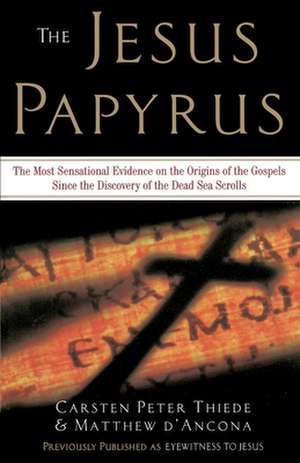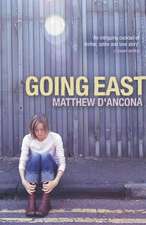The Jesus Papyrus: The Most Sensational Evidence on the Origins of the Gospels Since the Discovery of the Dead Sea Scrolls
Autor Carsten Peter Thiede, Matthew D'Anconaen Limba Engleză Paperback – 29 feb 2000
But what is all the fuss about? How can three ancient papyrus fragments be so significant? How did Thiede arrive at this radical early dating? And what does it mean to the average Christian? Now readers have authoritative answers to these pivotal questions, in a book written by Thiede himself and by Times of London journalist Matthew d'Ancona, who originally broke the story to the public. Indeed, the Magdalen Papyrus corroborates three traditions: Saint Matthew actually wrote the Gospel bearing his name; he wrote it within a generation of Jesus' death; and the Gospel stories about Jesus are true. Some will vehemently deny Thiede's claims, others will embrace them, but nobody can ignore THE JESUS PAPYRUS.
Preț: 89.70 lei
Nou
Puncte Express: 135
Preț estimativ în valută:
17.16€ • 17.97$ • 14.29£
17.16€ • 17.97$ • 14.29£
Carte disponibilă
Livrare economică 10-24 martie
Preluare comenzi: 021 569.72.76
Specificații
ISBN-13: 9780385488983
ISBN-10: 038548898X
Pagini: 224
Dimensiuni: 144 x 215 x 14 mm
Greutate: 0.3 kg
Editura: Galilee Book
ISBN-10: 038548898X
Pagini: 224
Dimensiuni: 144 x 215 x 14 mm
Greutate: 0.3 kg
Editura: Galilee Book
Notă biografică
CARSTEN PETER THIEDE directs the Institute for Basic Epistemological Research in his hometown of Paderborn, Germany. A former German National Scholarship Foundation Research Fellow at Queen's College, Oxford, he is an authority on ancient manuscripts. MATTHEW d'ANCONA lives in London, where his lead articles and special features for The Times are widely read. Winner of the 1994 Charles Douglas-Horne Award and the 1987 Oxford University H. W. C. David Prize in Modern History, he is also a fellow of All Souls College, Oxford.
Extras
The Magdalen College Papyrus: An Introduction
Jesus was at Bethany in the house of Simon the leper, when a woman came to him with a small bottle of fragrant oil, very costly; and as she sat at table she began to pour it over his head. --St. Matthew 26:6-7
We may start with the fact, which I confess I did not appreciate before the beginning of the investigation, of how little evidence there is for the dating of any of the New Testament writings. --John A. T. Robinson, Redating the New Testament (1976)
On Christmas Eve, 1994, The Times of London reported on its front page an astonishing claim made by the German biblical scholar Carsten Peter Thiede. "A papyrus believed to be the oldest extant fragment of the New Testament has been found in an Oxford library," the newspaper said. "It provides the first material evidence that the Gospel according to St. Matthew is an eyewitness account written by contemporaries of Christ."
The story concerned three tiny scraps of paper belonging to Magdalen College, Oxford, the largest of which is only 4.1 cm X 1.3 cm (1 5/8 in. X 1/2 in.). On both sides of the fragments appeared Greek script, phrases from the twenty-sixth chapter of St. Matthew, which describes Jesus' anointment in the house of Simon the leper at Bethany and his betrayal to the chief priests by Judas Iscariot. Though the verses concern a
crucial moment in thelife of Christ, the scraps looked unremarkable in themselves. Yet Thiede--Director of the Institute for Basic Epistemological Research in Paderborn, Germany--argued that they were of astonishingly early origin, dating from the mid-first century a.d. He was shortly to publish his claims in the Zeitschrift fur Papyrologie, a specialist journal for papyrologists (scholars who study ancient manuscript evidence on
papyrus).
The argument was complex, based upon expert analysis of the Greek writing on
the fragments and upon extensive comparisons with calligraphy on other manuscript fragments. A scholarly controversy was bound to follow, since Thiede was challenging the orthodox view that the tiny second-century fragment of St. John's Gospel in the John Rylands Library in Manchester was our earliest Gospel text. He was also making a claim which would have radical implications for our understanding of the Gospels and their origins. And--most important--he was doing so on the basis of physical evidence rather than literary theory or historical supposition.
The new claim clearly deserved a much broader audience than the comparatively small guild of papyrologists to whom Thiede's learned article was addressed.
Here, it was alleged, was a fragment of the twenty-sixth chapter of St. Matthew--remnants of a book perhaps 150 pages long--which might have been written in the lifetime of the apostle himself. Iftrue, Thiede's argument had far-reaching implications. As one senior fellow of Magdalen put it at the time: "It means that the people in the story must have been around when this was being written. It means they were there."
In its editorial column, The Times noted that many historians, theologians and linguists had speculated in the past that the New Testament was written by contemporaries or near contemporaries of Christ. "What separates Thiede from his academic predecessors," the editorial went on to say, "is that he has identified an artefact--albeit a tiny one--which seems to prove his point . . . This bold contention moves the debate on the antiquity of the New Testament into new territory."
None of this might have come to light had Thiede, whose wife is English, not
found himself in Oxford for a family celebration in February 1994. As a routine act of scholarly curiosity, he asked the assistant librarian at Magdalen College if he could take a look at the St. Matthew papyrus. He was struck and perplexed by what he saw--particularly that such an intriguing fragment had been so neglected since last being dated, to the second century, in the 1950s. Four visits to Oxford followed, in the course of which Thiede was able to study the papyrus in detail and refine his thesis.
When Anthony Smith, President of Magdalen, learned what Thiede was planning to argue, he made it his task to findout more about the fragments and how they had fallen into the hands of the college. How had this mysterious papyrus reached its twentieth-century home at Magdalen? The college records listed the donor as the Reverend Charles Bousfield Huleatt (1863-1908), a onetime undergraduate about whom almost nothing was known. Who was he and what was his part in the story of the papyrus?
Not since the discovery of the Dead Sea Scrolls in 1947 had there been such a potentially important breakthrough in biblical research. Thiede appeared to have found evidence that the St. Matthew Gospel was written only a generation after the Crucifixion--or even earlier. The papyrus itself, unearthed in Upper Egypt and bequeathed to Magdalen in 1901, might conceivably have been read or handled by one of the "five hundred brothers and sisters" (1 Corinthians 15:6) whom St. Paul declares to have seen the resurrected Jesus with their own eyes. It was a claim that nobody with an interest in Christianity--spiritual or scholarly--could possibly ignore.
Aware of the story's significance, The Times put its vast production halls in east London on security alert during its press run to prevent the news from leaking to a rival publication overnight. Only a handful of the newspaper's staff knew the details of what was to be published. But discreet
soundings in the scholarly world had alreadysuggested to them how much interest was likely to be generated by Thiede's claim and how fierce the scholarly debate would be.
So it has proved. In the days after The Times ran the story, it was picked up by news publications all over the world, from Los Angeles to New Delhi, while in Britain, the ITN news channel ran the story prominently on its prime-time bulletin. On January 23, 1995, Time magazine's Religious Editor, Richard Ostling, reported the new research under the bold and evocative headline "A Step Closer to Jesus?"
As expected, Thiede's argument provoked a powerful response, not least a vigorous correspondence in the letters columns of The Times. Some academics were hostile, arguing that the papyrus had been dated quite satisfactorily in 1953 to the late second century a.d. and that Thiede had done nothing to alter that consensus. In The Sunday Telegraph, the distinguished politician and scholar Enoch Powell dismissed Thiede's argument about the handwriting on the fragments as unfounded and "arrogant." Many others, however, commended Thiede's approach and wanted to learn more. "The problem is, this upsets the whole theological establishment," Ulrich Victor, a distinguished German classical philologist,
told Time magazine. Hugh Montefiore, the normally measured columnist of The Church Times, described the story breathlessly as a potential "bombshell."
Jesus was at Bethany in the house of Simon the leper, when a woman came to him with a small bottle of fragrant oil, very costly; and as she sat at table she began to pour it over his head. --St. Matthew 26:6-7
We may start with the fact, which I confess I did not appreciate before the beginning of the investigation, of how little evidence there is for the dating of any of the New Testament writings. --John A. T. Robinson, Redating the New Testament (1976)
On Christmas Eve, 1994, The Times of London reported on its front page an astonishing claim made by the German biblical scholar Carsten Peter Thiede. "A papyrus believed to be the oldest extant fragment of the New Testament has been found in an Oxford library," the newspaper said. "It provides the first material evidence that the Gospel according to St. Matthew is an eyewitness account written by contemporaries of Christ."
The story concerned three tiny scraps of paper belonging to Magdalen College, Oxford, the largest of which is only 4.1 cm X 1.3 cm (1 5/8 in. X 1/2 in.). On both sides of the fragments appeared Greek script, phrases from the twenty-sixth chapter of St. Matthew, which describes Jesus' anointment in the house of Simon the leper at Bethany and his betrayal to the chief priests by Judas Iscariot. Though the verses concern a
crucial moment in thelife of Christ, the scraps looked unremarkable in themselves. Yet Thiede--Director of the Institute for Basic Epistemological Research in Paderborn, Germany--argued that they were of astonishingly early origin, dating from the mid-first century a.d. He was shortly to publish his claims in the Zeitschrift fur Papyrologie, a specialist journal for papyrologists (scholars who study ancient manuscript evidence on
papyrus).
The argument was complex, based upon expert analysis of the Greek writing on
the fragments and upon extensive comparisons with calligraphy on other manuscript fragments. A scholarly controversy was bound to follow, since Thiede was challenging the orthodox view that the tiny second-century fragment of St. John's Gospel in the John Rylands Library in Manchester was our earliest Gospel text. He was also making a claim which would have radical implications for our understanding of the Gospels and their origins. And--most important--he was doing so on the basis of physical evidence rather than literary theory or historical supposition.
The new claim clearly deserved a much broader audience than the comparatively small guild of papyrologists to whom Thiede's learned article was addressed.
Here, it was alleged, was a fragment of the twenty-sixth chapter of St. Matthew--remnants of a book perhaps 150 pages long--which might have been written in the lifetime of the apostle himself. Iftrue, Thiede's argument had far-reaching implications. As one senior fellow of Magdalen put it at the time: "It means that the people in the story must have been around when this was being written. It means they were there."
In its editorial column, The Times noted that many historians, theologians and linguists had speculated in the past that the New Testament was written by contemporaries or near contemporaries of Christ. "What separates Thiede from his academic predecessors," the editorial went on to say, "is that he has identified an artefact--albeit a tiny one--which seems to prove his point . . . This bold contention moves the debate on the antiquity of the New Testament into new territory."
None of this might have come to light had Thiede, whose wife is English, not
found himself in Oxford for a family celebration in February 1994. As a routine act of scholarly curiosity, he asked the assistant librarian at Magdalen College if he could take a look at the St. Matthew papyrus. He was struck and perplexed by what he saw--particularly that such an intriguing fragment had been so neglected since last being dated, to the second century, in the 1950s. Four visits to Oxford followed, in the course of which Thiede was able to study the papyrus in detail and refine his thesis.
When Anthony Smith, President of Magdalen, learned what Thiede was planning to argue, he made it his task to findout more about the fragments and how they had fallen into the hands of the college. How had this mysterious papyrus reached its twentieth-century home at Magdalen? The college records listed the donor as the Reverend Charles Bousfield Huleatt (1863-1908), a onetime undergraduate about whom almost nothing was known. Who was he and what was his part in the story of the papyrus?
Not since the discovery of the Dead Sea Scrolls in 1947 had there been such a potentially important breakthrough in biblical research. Thiede appeared to have found evidence that the St. Matthew Gospel was written only a generation after the Crucifixion--or even earlier. The papyrus itself, unearthed in Upper Egypt and bequeathed to Magdalen in 1901, might conceivably have been read or handled by one of the "five hundred brothers and sisters" (1 Corinthians 15:6) whom St. Paul declares to have seen the resurrected Jesus with their own eyes. It was a claim that nobody with an interest in Christianity--spiritual or scholarly--could possibly ignore.
Aware of the story's significance, The Times put its vast production halls in east London on security alert during its press run to prevent the news from leaking to a rival publication overnight. Only a handful of the newspaper's staff knew the details of what was to be published. But discreet
soundings in the scholarly world had alreadysuggested to them how much interest was likely to be generated by Thiede's claim and how fierce the scholarly debate would be.
So it has proved. In the days after The Times ran the story, it was picked up by news publications all over the world, from Los Angeles to New Delhi, while in Britain, the ITN news channel ran the story prominently on its prime-time bulletin. On January 23, 1995, Time magazine's Religious Editor, Richard Ostling, reported the new research under the bold and evocative headline "A Step Closer to Jesus?"
As expected, Thiede's argument provoked a powerful response, not least a vigorous correspondence in the letters columns of The Times. Some academics were hostile, arguing that the papyrus had been dated quite satisfactorily in 1953 to the late second century a.d. and that Thiede had done nothing to alter that consensus. In The Sunday Telegraph, the distinguished politician and scholar Enoch Powell dismissed Thiede's argument about the handwriting on the fragments as unfounded and "arrogant." Many others, however, commended Thiede's approach and wanted to learn more. "The problem is, this upsets the whole theological establishment," Ulrich Victor, a distinguished German classical philologist,
told Time magazine. Hugh Montefiore, the normally measured columnist of The Church Times, described the story breathlessly as a potential "bombshell."
Recenzii
"New Testament scholarship may be revolutionized by three old scraps of papyrus no bigger than postage stamps."--Richard N. Ostling, Time
Descriere
This compelling story shows how three small papyrus fragments vaulted from near-obscurity to become recognized as the treasured missing proof that Matthew was an eyewitness to Jesus. 8-page photo insert.








